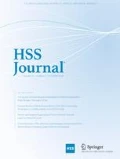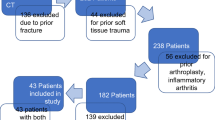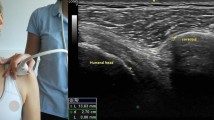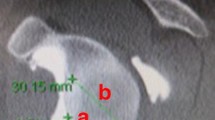Abstract
Background
Although the reliability of determining acromial morphology has been examined, to date, there has not been an analysis of interobserver and intraobserver reliability on determining the presence and measuring the size of an acromial enthesophyte.
Questions/Purposes
The hypothesis of this study was that there will be poor intraobserver and interobserver reliability in the (1) determination of the presence of an acromial enthesophyte, (2) determination of the size of an acromial enthesophyte, and (3) determination of acromial morphology.
Patients and Methods
Fifteen fellowship-trained orthopedic shoulder surgeons reviewed the radiographs of 15 patients at two different intervals. Measurement of acromial enthesophytes was performed using two techniques: (1) enthesophyte length and (2) enthesophyte–humeral distance. Acromial morphology was also determined. Interobserver and intraobserver agreement was determined using intraclass correlation and kappa statistical methods.
Results
The interobserver reliability was fair to moderate and the intraobserver reliability moderate for determining the presence of an acromial enthesophyte. The measurement of the enthesophyte length showed poor interobserver and intraobserver reliability. The measurement of the enthesophyte–humeral distance showed poor interobserver reliability and moderate intraobserver reliability. The interobserver and intraobserver reliability in determining acromial morphology was found to be moderate and good, respectively.
Conclusions
There is fair to moderate reliability among fellowship-trained shoulder surgeons in determining the presence of an acromial enthesophyte. However, there is poor reliability among observers in measuring the size of the enthesophyte. This study suggests that the enthesophyte–humeral distance may be more reliable than the enthesophyte length when measuring the size of the enthesophyte.


Similar content being viewed by others
References
Aoki M, Ishii S, Usui M. The morphology of the acromion and its relationship to rotator cuff impingement. Orthop Trans. 1986;10:228.
Banas MP, Miller RJ, Totterman S. Relationship between the lateral acromion angle and rotator cuff disease. J Shoulder Elbow Surg. 1995;4(6):454–461.
Bigliani LU, Morrison DS, April EW. The morphology of the acromion and its relationship to rotator cuff tears. Orthop Trans. 1986;10:216.
Bright AS, Torpey B, Magid D, Codd T, McFarland EG. Reliability of radiographic evaluation for acromial morphology. Skeletal Radiol. 1997;26(12):718–721.
Chambler AF, Bull AM, Reilly P, Amis AA, Emery RJ. Coracoacromial ligament tension in vivo. J Shoulder Elbow Surg. 2003;12(4):365–367.
Chambler AF, Emery RJ. Acromial morphology: the enigma of terminology. Knee Surg Sports Traumatol Arthrosc. 1997;5(4):268–272.
Chambler AF, Pitsillides AA, Emery RJ. Acromial spur formation in patients with rotator cuff tears. J Shoulder Elbow Surg. 2003;12(4):314–321.
Edelson JG. The ‘hooked’ acromion revisited. J Bone Joint Surg Br. 1995;77(2):284–287.
Edelson JG, Taitz C. Anatomy of the coraco-acromial arch. Relation to degeneration of the acromion. J Bone Joint Surg Br. 1992;74(4):589–594.
Epstein RE, Schweitzer ME, Frieman BG, Fenlin JM, Jr., Mitchell DG. Hooked acromion: prevalence on MR images of painful shoulders. Radiology. 1993;187(2):479–481.
Farley TE, Neumann CH, Steinbach LS, Petersen SA. The coracoacromial arch: MR evaluation and correlation with rotator cuff pathology. Skeletal Radiol. 1994;23(8):641–645.
Fealy S, April EW, Khazzam M, Armengol-Barallat J, Bigliani LU. The coracoacromial ligament: morphology and study of acromial enthesopathy. J Shoulder Elbow Surg. 2005;14(5):542–548.
Fleiss J. Statistical methods for rates and proportions, 2nd edition. New York: Wiley; 1981.
Getz JD, Recht MP, Piraino DW, Schils JP, Latimer BM, Jellema LM, et al. Acromial morphology: relation to sex, age, symmetry, and subacromial enthesophytes. Radiology. 1996;199(3):737–742.
Gill TJ, McIrvin E, Kocher MS, Homa K, Mair SD, Hawkins RJ. The relative importance of acromial morphology and age with respect to rotator cuff pathology. J Shoulder Elbow Surg. 2002;11(4):327–330.
Graves WW. Observation on ages changes in the scapula. Am j Phys Anthrop. 1922;5:21–34.
Haygood TM, Langlotz CP, Kneeland JB, Iannotti JP, Williams GR, Jr., Dalinka MK. Categorization of acromial shape: interobserver variability with MR imaging and conventional radiography. AJR Am J Roentgenol. 1994;162(6):1377–1382.
Hirano M, Ide J, Takagi K. Acromial shapes and extension of rotator cuff tears: magnetic resonance imaging evaluation. J Shoulder Elbow Surg. 2002;11(6):576–578.
Jacobson SR, Speer KP, Moor JT, Janda DH, Saddemi SR, MacDonald PB, et al. Reliability of radiographic assessment of acromial morphology. J Shoulder Elbow Surg. 1995;4(6):449–453.
Karanicolas PJ, Bhandari M, Kreder H, Moroni A, Richardson M, Walter SD, et al. Evaluating agreement: conducting a reliability study. J Bone Joint Surg Am. 2009;91 Suppl 3:99–106.
Kitay GS, Iannotti JP, Williams GR, Haygood T, Kneeland BJ, Berlin J. Roentgenographic assessment of acromial morphologic condition in rotator cuff impingement syndrome. J Shoulder Elbow Surg. 1995;4(6):441–448.
Kramer M. Undersurface acromial osteophyte or deltoid tendon attachment to the acromion? AJR Am J Roentgenol. 2008;190(6):W376-377; author reply W378.
Landis JR, Koch GG. The measurement of observer agreement for categorical data. Biometrics. 1977;33(1):159–174.
MacGillivray JD, Fealy S, Potter HG, O’Brien SJ. Multiplanar analysis of acromion morphology. Am J Sports Med. 1998;26(6):836–840.
Mahakkanukrauh P, Surin P. Prevalence of osteophytes associated with the acromion and acromioclavicular joint. Clin Anat. 2003;16(6):506–510.
Mayerhoefer ME, Breitenseher MJ, Roposch A, Treitl C, Wurnig C. Comparison of MRI and conventional radiography for assessment of acromial shape. AJR Am J Roentgenol. 2005;184(2):671–675.
Milz S, Jakob J, Buttner A, Tischer T, Putz R, Benjamin M. The structure of the coracoacromial ligament: fibrocartilage differentiation does not necessarily mean pathology. Scand J Med Sci Sports. 2008;18:16–22.
Morrison DS, Frogameni AD, Woodworth P. Non-operative treatment of subacromial impingement syndrome. J Bone Joint Surg Am. 1997;79(5):732–737.
Natsis K, Tsikaras P, Totlis T, Gigis I, Skandalakis P, Appell HJ, et al. Correlation between the four types of acromion and the existence of enthesophytes: a study on 423 dried scapulas and review of the literature. Clin Anat. 2007;20(3):267–272.
Neer CS, 2nd. Anterior acromioplasty for the chronic impingement syndrome in the shoulder: a preliminary report. J Bone Joint Surg Am. 1972;54(1):41–50.
Nicholson GP, Goodman DA, Flatow EL, Bigliani LU. The acromion: morphologic condition and age-related changes. A study of 420 scapulas. J Shoulder Elbow Surg. 1996;5(1):1–11.
Ogata S, Uhthoff HK. Acromial enthesopathy and rotator cuff tear. A radiologic and histologic postmortem investigation of the coracoacromial arch. Clin Orthop Relat Res. 1990(254):39–48.
Ogawa K, Yoshida A, Inokuchi W, Naniwa T. Acromial spur: relationship to aging and morphologic changes in the rotator cuff. J Shoulder Elbow Surg. 2005;14(6):591–598.
Panni AS, Milano G, Lucania L, Fabbriciani C, Logroscino CA. Histological analysis of the coracoacromial arch: correlation between age-related changes and rotator cuff tears. Arthroscopy. 1996;12(5):531–540.
Paraskevas G, Tzaveas A, Papaziogas B, Kitsoulis P, Natsis K, Spanidou S. Morphological parameters of the acromion. Folia Morphol (Warsz). 2008;67(4):255–260.
Park TS, Park DW, Kim SI, Kweon TH. Roentgenographic assessment of acromial morphology using supraspinatus outlet radiographs. Arthroscopy. 2001;17(5):496–501.
Pearsall AWt, Bonsell S, Heitman RJ, Helms CA, Osbahr D, Speer KP. Radiographic findings associated with symptomatic rotator cuff tears. J Shoulder Elbow Surg. 2003;12(2):122–127.
Portney L, Watkins M. Foundations of Clinical Research: Applications to Practice. New Jersey Prentice Hall Health; 2000.
Sangiampong A, Chompoopong S, Sangvichien S, Thongtong P, Wongjittraporn S. The acromial morphology of Thais in relation to gender and age: study in scapular dried bone. J Med Assoc Thai. 2007;90(3):502–507.
Taheriazam A, Sadatsafavi M, Moayyeri A. Outcome predictors in nonoperative management of newly diagnosed subacromial impingement syndrome: a longitudinal study. MedGenMed. 2005;7(1):63.
Toivonen DA, Tuite MJ, Orwin JF. Acromial structure and tears of the rotator cuff. J Shoulder Elbow Surg. 1995;4(5):376–383.
Wang JC, Horner G, Brown ED, Shapiro MS. The relationship between acromial morphology and conservative treatment of patients with impingement syndrome. Orthopedics. 2000;23(6):557–559.
Wang JC, Shapiro MS. Changes in acromial morphology with age. J Shoulder Elbow Surg. 1997;6(1):55–59.
Zuckerman JD, Kummer FJ, Cuomo F, Greller M. Interobserver reliability of acromial morphology classification: an anatomic study. J Shoulder Elbow Surg. 1997;6(3):286–287.
Acknowledgements
This research was supported by Grant Number 5 K23 AR052392-04 from the National Institute of Arthritis and Musculoskeletal and Skin Diseases. This network has received research funding from Arthrex and NFL Charities.
Author information
Authors and Affiliations
Corresponding author
Additional information
Each author certifies that he has no commercial associations (e.g., consultancies, stock ownership, equity interest, patent/licensing arrangements, etc.) that might pose a conflict of interest in connection with the submitted article.
Multi-centered Orthopaedic Outcomes Network (MOON) for the Shoulder
The corresponding author certifies that his institution has approved the human protocol for this investigation and that all investigations were conducted in conformity with ethical principles of research (Avera Institutional Review Board #2007.060E).
Level of Evidence: Level III Diagnostic Study
Rights and permissions
About this article
Cite this article
Baumgarten, K.M., Carey, J.L., Abboud, J.A. et al. Reliability of Determining and Measuring Acromial Enthesophytes. HSS Jrnl 7, 218–222 (2011). https://doi.org/10.1007/s11420-011-9209-0
Received:
Accepted:
Published:
Issue Date:
DOI: https://doi.org/10.1007/s11420-011-9209-0




